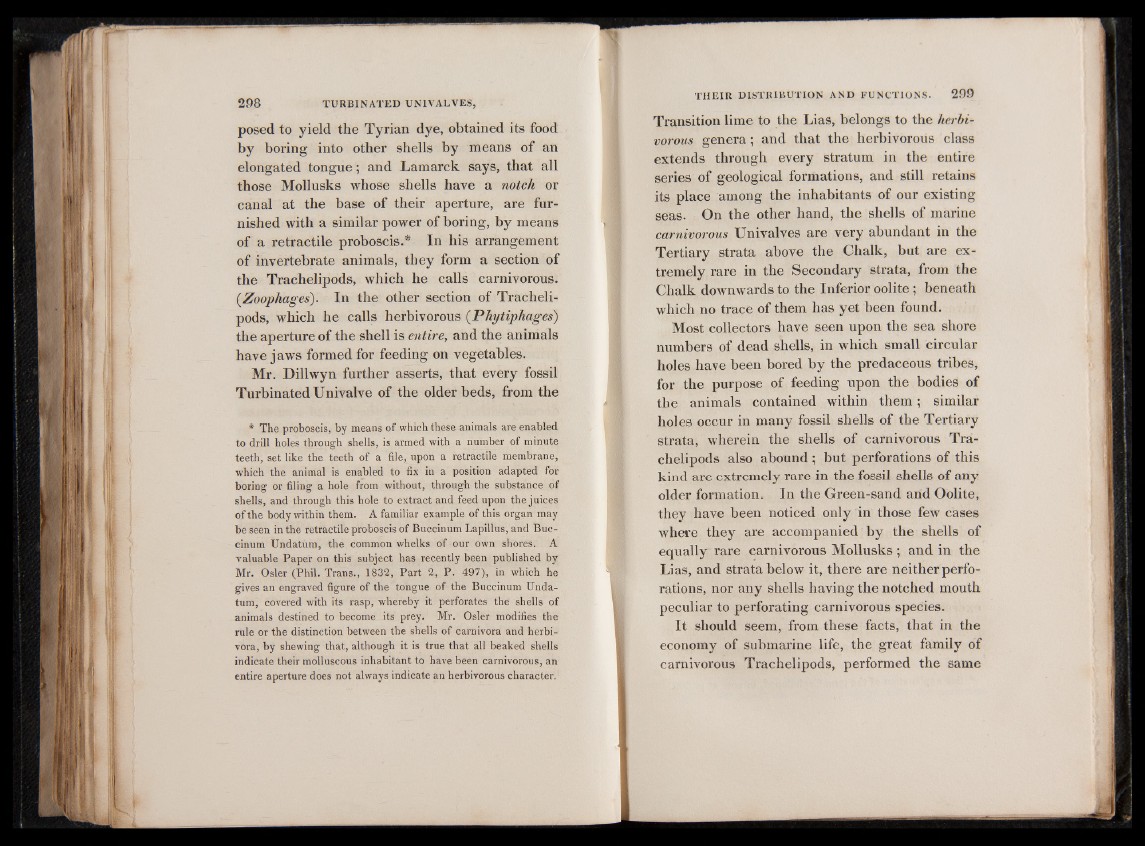
posed to yield the Tyrian dye, obtained its food
by boring into other shells by means of an
elongated tongue; and Lamarck says, that all
those Mollusks whose shells have a notch or
canal at the base of their aperture, are furnished
with a similar power of boring, by means
of a retractile proboscis.* In his arrangement
of invertebrate animals, they form a section of
the Trachelipods, which he calls carnivorous.
{Zoophages). In the other section of Trachelipods,
which he calls herbivorous (Phytiphages)
the aperture of the shell is entire, and the animals
have jaws formed for feeding on vegetables.
Mr. Dillwyn further asserts, that every fossil
Turbinated Univalve of the older beds, from the
* The proboscis, by means of which these animals are enabled
to drill holes through shells, is armed with a number of minute
teeth, set like the teeth of a file, upon a retractile membrane,
which the animal is enabled to fix in a position adapted for
boring or filing a hole from without, through the substance of
shells, and through this hole to extract and feed upon the juices
of the body within them. A familiar example of this organ may
be seen in the retractile proboscis of Buccinum Lapillus, and Buc-
cinum Undatum, the common whelks of our own shores. A
valuable Paper on this subject has recently been published by
Mr. Osier (Phil. Trans., 1832, Part 2, P. 497), in which he
gives an engraved figure of the tongue of the Buccinum Undatum,
covered with its rasp, whereby it perforates the shells of
animals destined to become its prey. Mr. Osier modifies the
rule or the distinction between the shells of carnivora and herbi-
vora, by shewing that, although it is true that all beaked shells
indicate their molluscous inhabitant to have been carnivorous, an
entire aperture does not always indicate an herbivorous character.
THEIR DISTRIBUTION AND FUNCTIONS. 299
Transition lime to the Lias, belongs to the herbivorous
genera; and that the herbivorous class
extends through every stratum in the entire
series of geological formations, and still retains
its place among the inhabitants of our existing
seas. On the other hand, the shells of marine
carnivorous Univalves are very abundant in the
Tertiary strata above the Chalk, but are extremely
rare in the Secondary strata, from the
Chalk downwards to the Inferior oolite; beneath
which no trace of them has yet been found.
Most collectors have seen upon the sea shore
numbers of dead shells, in which small circular
holes have been bored by the predaceous tribes,
for the purpose of feeding upon the bodies of
the animals contained within them; similar
holes occur in many fossil shells of the Tertiary
strata, wherein the shells of carnivorous Trachelipods
also abound ; but perforations of this
kind are extremely rare in the fossil shells of any
older formation. In the Green-sand and Oolite,
they have been noticed only in those few cases
where they are accompanied by the shells of
equally rare carnivorous Mollusks; and in the
Lias, and strata below it, there are neither perforations,
nor any shells having the notched mouth
peculiar to perforating carnivorous species.
It should seem, from these facts, that in the
economy of submarine life, the great family of
carnivorous Trachelipods, performed the same